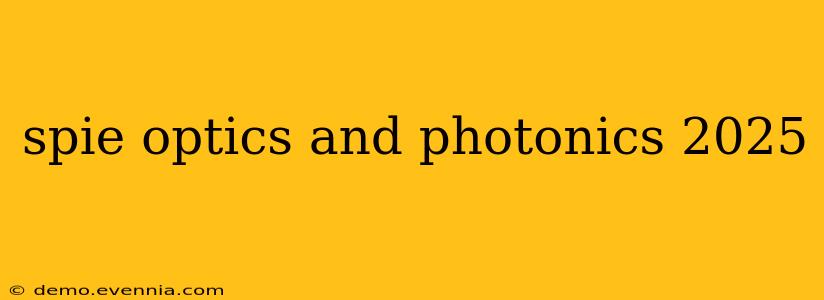SPIE Optics + Photonics 2025, held in San Diego, California, marked another significant milestone in the field of optics and photonics. While the event itself is past, analyzing its impact and looking towards future trends remains crucial for researchers, engineers, and industry professionals alike. This retrospective examines key highlights from the 2025 event and explores the exciting advancements shaping the future of the field.
Key Themes and Highlights of SPIE Optics + Photonics 2025
SPIE Optics + Photonics 2025 showcased a diverse range of cutting-edge technologies and research. Several key themes emerged as particularly impactful:
1. Advancements in Biomedical Optics:
The conference featured significant advancements in biomedical optics, including breakthroughs in optical microscopy, biophotonics imaging, and therapeutic applications. Researchers presented innovative techniques for early disease detection, minimally invasive surgery, and personalized medicine. The development of new optical probes and imaging modalities received significant attention, promising to revolutionize medical diagnostics and treatment.
2. Progress in Optical Sensing and Metrology:
Significant progress in optical sensing and metrology was another major focus. Presentations highlighted new sensor technologies for environmental monitoring, industrial automation, and precision measurement. The development of compact, highly sensitive, and cost-effective sensors is driving innovation across numerous sectors, including aerospace, manufacturing, and healthcare. Specific advancements in fiber optic sensing and laser-based metrology were particularly noteworthy.
3. Photonic Integrated Circuits (PICs) and their Applications:
The growing importance of photonic integrated circuits (PICs) was evident throughout the conference. Discussions centered on the development of highly integrated PICs for applications in high-speed optical communication, data centers, and LiDAR systems. The potential for miniaturization, reduced power consumption, and enhanced performance continues to drive investment and research in this critical area.
4. Artificial Intelligence and Machine Learning in Optics:
The integration of artificial intelligence (AI) and machine learning (ML) techniques within optical systems is rapidly accelerating. SPIE Optics + Photonics 2025 featured numerous presentations showcasing AI-powered image processing, advanced optical design optimization, and intelligent control systems. This convergence is expected to lead to more sophisticated and autonomous optical systems capable of adapting to dynamic environments and performing complex tasks.
Looking Ahead: Future Trends in Optics and Photonics
Based on the insights gained from SPIE Optics + Photonics 2025 and broader industry trends, several key areas are poised for significant growth in the coming years:
-
Quantum Optics and Quantum Technologies: The field of quantum optics is rapidly maturing, with significant potential for applications in quantum computing, quantum communication, and quantum sensing. Expect to see increased investment and research in this transformative area.
-
Metamaterials and Metasurfaces: Advanced metamaterials and metasurfaces are opening up new possibilities for manipulating light at the nanoscale. Their applications range from improved optical devices to advanced camouflage technologies.
-
Free-Space Optical Communication: Free-space optical communication offers the potential for high-bandwidth, secure communication links, particularly in challenging environments. Further advancements in this area are likely to drive its adoption in various sectors.
-
Sustainable Photonics: The development of energy-efficient and environmentally friendly photonic technologies is becoming increasingly important. Research efforts focused on sustainable materials, manufacturing processes, and device designs are expected to gain momentum.
Conclusion: The Ongoing Evolution of Optics and Photonics
SPIE Optics + Photonics 2025 served as a valuable platform for showcasing the latest breakthroughs and fostering collaboration within the optics and photonics community. The conference underscored the dynamic and rapidly evolving nature of the field, with significant advancements across diverse applications. As we look ahead, the integration of AI, quantum technologies, and sustainable practices will likely shape the future of optics and photonics, driving innovation and creating exciting opportunities for years to come. The continued exploration of these themes will be crucial to unlocking the full potential of this transformative technology.

